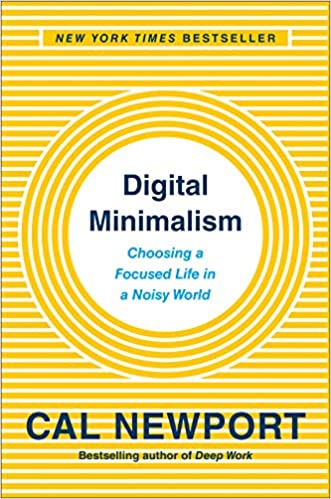Digital Minimalism by Cal Newport
The Book in 1 Sentences
Digital Minimalism: Choosing a Focused Life in a Noisy World
“Much in the same way that the ‘innovation’ of highly processed foods in the mid-twentieth
century led to a global health crisis, the unintended side effects of digital communication tools—a sort of social fast food— are proving to be similarly worrisome.” ~ Cal Newport
15 BIG Ideas
Digital Minimalism Book Summary
1. Why Do We Need Digital Minimalism?
“Our current relationship with the technologies of our hyper-connected world is unsustainable and is leading us closer to the quiet desperation that Thoreau observed so many years ago. But as Thoreau reminds us, ‘the sun rose clear’ and we still have the ability to change this state of affairs.
To do so, however, we cannot passively allow the wild tangle of tools, entertainments, and distractions provided by the internet age to dictate how we spend our time or how we feel. We must indeed take steps to extract the good from these technologies while sidestepping what’s bad.
We require a philosophy that puts our aspirations and values once again in charge of our daily experience, all the while dethroning primal whims and the business models of Silicon Valley from their current dominance of this role; a philosophy that accepts new technologies, but not if the price is the dehumanization Andrew Sullivan warned us about; a philosophy that prioritizes long-term meaning over short-term satisfaction.
A philosophy, in other words, like digital minimalism.”
2. A Lopsided Arms Race
“The fact that our humanity was routed by these tools over the past decade should come
as no surprise. As I just detailed, we’ve been engaging in a lopsided arms race in which the
technologies encroaching on our autonomy were preying with increasing precision on deepseated vulnerabilities in our brains, while we still naively believed that we were just fiddling with fun gifts handed down from the nerd gods.
When Bill Maher joked that the App Store was coming for our souls, he was actually onto
something. As Socrates explained to Phaedrus in Plato’s famous chariot metaphor, our soul
can be understood as a chariot driver struggling to rein two horses, one representing our better nature and the other our baser impulses.
When we increasingly cede autonomy to the digital, we energize the latter horse and make the chariot driver’s struggle to steer increasingly difficult—a diminishing of our soul’s authority.
When seen from this perspective, it becomes clear that this is a battle we must fight. But to do so, we need a more serious strategy, something custom built to swat aside the forces manipulating us toward behavioral addictions and that offers a concrete plan about how to put new technologies to use for our best aspirations not against them.
Digital minimalism is one such strategy. It’s toward its details that we now turn our attention.”
“A natural conclusion of this reality is that we should treat with great care any new technology that threatens to disrupt the ways in which we connect and communicate with others. When you mess with something so central to the success of our species, it’s easy to create problems.”
“The sugar high of convenience is fleeting and the sting of missing out dulls rapidly, but the meaningful glow that comes from taking charge of what claims your time and attention is something that persists.”
3. What is Digital Minimalism?
“Digital Minimalism
A philosophy of technology use in which you focus your online time on a small number of carefully selected and optimized activities that strongly support things you value, and then happily miss out on everything else.
The so-called digital minimalists who follow this philosophy constantly perform implicit
cost-benefit analyses. If a new technology offers little more than a minor diversion or trivial
convenience, the minimalist will ignore it.
Even when a new technology promises to support something the minimalist values, it must still pass a stricter test: is this the best way to use technology to support this value? If the answer is no, the minimalist will set to work trying to optimize the tech, or search out a better option.
By working backward from their deep values to their technology choices, digital minimalists
transform these innovations from a source of distraction into tools to support a life well lived.
By doing so, they break the spell that has made so many people feel like they’re losing control to their screens.”
“It’s a mistake to think of the digital declutter as only a detox experience. The goal is not to simply give yourself a break from technology, but to instead spark a permanent transformation of your digital life. The detoxing is merely a step that supports this transformation.”
4. Spend Time Alone
“Returning to our canary-in-the-coal-mine analogy, the plight of iGen provides a strong
warning about the danger of solitude deprivation. When an entire cohort unintentionally
eliminated time alone with their thoughts from their lives, their mental health suffered
dramatically.
On reflection, this makes sense. These teenagers have lost the ability to process and make sense of their emotions, or to reflect on who they are and what really matters, or to build strong relationships, or even to just allow their brains time to power down their critical social circuits, which are not meant to be used constantly, and to redirect that energy to other important cognitive housekeeping tasks.
We shouldn’t be surprised that these absences lead to malfunctions.
Most adults stop short of the constant connectivity practiced by members of iGen, but if you
extrapolate these effects to the somewhat milder forms of solitude deprivation that have become common among many different age groups, the results are still worrisome.
As I’ve learned by interacting with my readers, many have come to accept a background hum of low-grade anxiety that permeates their daily lives. When looking for explanations, they might turn to the latest crises—be it the recession of 2009 or the contentious election of 2016—or chalk it up to a normal reaction to the stresses of adulthood.
But once you begin studying the positive benefits of spending time alone with your thoughts, and encounter the distressing effects that appear in populations that eliminate this altogether, a simple explanation emerges: we need solitude to thrive as human beings, and in recent years, without even realizing it, we’ve been systematically reducing this crucial ingredient from our lives.
Simply put, humans are not wired to be constantly wired.”
“Solitude Deprivation: A state in which you spend close to zero time alone with your thoughts and free from input from other minds.”
“Erecting barriers against the existential is not new—before YouTube we had (and still have) mindless television and heavy drinking to help avoid deeper questions—but the advanced technologies of the twenty-first century attention economy are particularly effective at this task.”
5. Reclaim Leisure
“The state I’m helping you escape is one in which passive interaction with your screens is your
primary leisure. I want you to replace this with a state where your leisure time is now filled
with better pursuits, many of which will exist primarily in the physical world.
In this new state, digital technology is still present, but now subordinated to a support role: helping you to set up or maintain your leisure activities, but not acting as the primary source of leisure themselves.
Spending an hour browsing funny YouTube clips might sap your vitality, while—and I’m
speaking from recent experience here—using YouTube to teach yourself how to replace a motor in a bathroom ventilation fan can provide the foundation for a satisfying afternoon of tinkering.
A foundational theme in digital minimalism is that new technology, when used with care and
intention, creates a better life than either Luddism or mindless adoption.”
“Earlier, I cited extensive research that supports the claim that the human brain has evolved to process the flood of information generated by face-to-face interactions. To replace this rich flow with a single bit [of clicking ‘Like’]is the ultimate insult to our social processing machinery.
To say it’s like driving a Ferrari under the speed limit is an understatement; the better simile is towing a Ferrari behind a mule.”
6. Join the Attention Resistance
“The lopsidedness of this battle is a big part of the reason I never messed around with any of
these services in the first place. To repeat a line from the New Yorker writer George Packer,
‘[Twitter] scares me, not because I’m morally superior to it, but because I don’t think I could
handle it. I’m afraid I’d end up letting my own son go hungry.’
If you must use these services, however, and you hope to do so without ceding autonomy over your time and attention, it’s crucial to understand that this is not a casual decision. You’re instead waging a David and Goliath battle against institutions that are both impossibly rich and intent on using this wealth to stop you from winning.
Put another way, to approach attention economy services with the intentionality proposed by
Ginsberg and Burke is not a commonsense adjustment to your digital habits, but is instead
better understood as a bold act of resistance.
Fortunately, if you take this path, you’ll not be alone. My research on digital minimalism has revealed the existence of a loosely organized attention resistance movement, made up of individuals who combine high-tech tools with disciplined operating procedures to conduct surgical strikes on popular attention economy services—dropping in to extract value, and then slipping away before the attention traps set by these companies can spring shut.”
“Declaring freedom from your smartphone is probably the most serious step you
can take toward embracing the attention resistance.
This follows because smartphones are the preferred Trojan horse of the digital attention economy.”
“Digital minimalism definitively does not reject innovations of the internet age, but instead
rejects the way so many people currently engage in those tools.”
That was my QUICK summary of the great book Digital Minimalism by Cal Newport. If you’re interested, get your copy. There is a HUGE amount of wisdom and life-changing ideas in this book, and we’ve only touched on a tiny bit of it.
Buy The Book: Digital Minimalism by Cal Newport

GET Blinkist 7 Days FREE Trial
3000+ Book Summaries
(Audio and Text)






